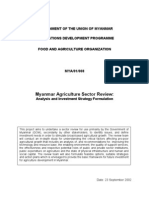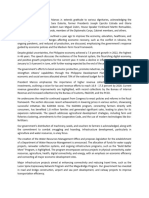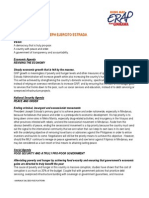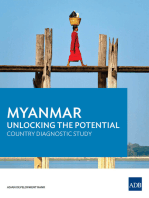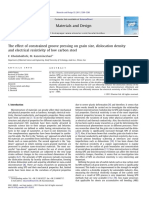DA Timeline Revision From Ms. Malou Alcid
DA Timeline Revision From Ms. Malou Alcid
Uploaded by
Jeroley C SahagunCopyright:
Available Formats
DA Timeline Revision From Ms. Malou Alcid
DA Timeline Revision From Ms. Malou Alcid
Uploaded by
Jeroley C SahagunCopyright
Available Formats
Share this document
Did you find this document useful?
Is this content inappropriate?
Copyright:
Available Formats
DA Timeline Revision From Ms. Malou Alcid
DA Timeline Revision From Ms. Malou Alcid
Uploaded by
Jeroley C SahagunCopyright:
Available Formats
DA Group Members: 1. 2. 3. 4. 5. 6. 7. 8. 9. 10. 11. 12. 13.
HAZEL ANN ALFORJA JEROLET SAHAGUN MARY ANN VIRTUDES BERNARD PACETE JOHNDOM DOMAGTOY RONALD CANABE BERNARD PACETE JOHNDOM DOMAGTOY RONALD CANABE JESSA HONEYLET FONG JOEL MATIRA KEN RYAN ELEAZAR RONDELL RAY MANJARRES
Rural Development Models of the Department of Agriculture from 1986 to Present 1. Agree on your criteria for dividing the timeline into distinct periods (e.g. by themes, or presidential administration, or by decade) 2. Identify clearly the social problem/issue to be addressed per period. 3. Describe the major internal (e.g. presidential and Cabinet priorities, agency bureaucracy) and external influences (e.g. public pressure, priorities of donor agencies, internationa commitments) in developing the program response/s. 4. Do the flagship programs implemented for each period constitute a distinct RD model? If yes, how does your group or your agency name and characterise this RD model? 5. If there are changes in RD models throught the periods, explain how they differ from one period to the next. 6. In addition to your ppt, write a narrative in response to Items Nos. 1-5 above. Minimum of five (5) pages, single spaced, following APA citation style. The DA group had decided to divide the timeline into presidential era. The mandate of Department of Agriculture is as principal agency of the Philippine government responsible for the promotion of agricultural and fisheries development and growth. In pursuit of this, it provides a policy framework that directs public investments and, in partnership with the local government units (LGUs), provides the support services necessary to make agriculture and fisheries, and agri-based enterprises profitable and to help spread the benefits of development to the poor, particularly those in the rural areas. The vision of the agency is the creation of prosperous rural
communities in the Philippines built on profitable farms that provide surplus for agro-industry and guarantees food security. The imbibed mission of the department is to increase the income of farmers and fisherfolk, thereby contributing to the achievement of the national goals of alleviating poverty, generating productive opportunities, fostering social justice and equity, and promoting sustainable economic growth1. This paper is focused on the rural development models of the Department of Agriculture from 1986 to present. Therefore the discussion will start during Corys regime and ends until the current P-Noy administration. Corazon Aquino administration Economic policies centered on bringing back economic health and confidence focused on creating a market-oriented and socially responsible economy. The significance impacts of the developmental programs of Corys administration were hindered by the countrys fiscal constraints. The regime was post EDSA1 revolution that ousted the two decade dictatorship of President Marcos. The inherited major social problems that the Aquino administration tried to address were poverty and high unemployment rate. The National Government had focused its role on providing new opportunities and an environment conducive to farming and fishing communities which enable them to engage in agribusiness ventures. 2 The immediate priority of the Department of Agriculture under the leadership of Secretary Dominguez was to hasten the agricultural development in the rural communities and increase farmers income as well as to develop the entrepreneurial skills of small farmers in managing rural-based industries.3 The rural development strategies of the Aquino Administration as stated in the LEAD Program Guidelines are the following: 1. Provision of income generating projects with interest and collateral free start-up funds 2. Development and enhancement of entrepreneurial skills of farmers and fishers in managing rural-based enterprises 3. Strengthen linkages with the LGU 4. Involvement of peoples organizations in the evaluation, approval and monitoring of projects. The above mentioned strategies used during the time of President Cory Aquino are still being utilized until now by the Department of Agriculture through its different program which include SELAP program and AKBay Program.
1 2
Retrieved on 09 January 2013 from www.da.gov.ph/ LEAD- Buklod Yaman Program Guidelines
Ibid
Fidel V. Ramos Administration The development frameworks of President Ramos administration were Economic Growth and Sustainable Development. The Department of Agriculture had programs that have provision for supply in equal measure for agriculture sector since almost half of people in the community are largely dependent on agriculture. The strategy for rural development include the dismantling of protectionist barriers and providing correct incentives and support shall make the agriculture sector and related businesses to become more efficient and world-competitiveaiming the Philippine exports to spearhead for economic revival and growth of the country. Joseph E. Estrada Administration The President Estrada rural development strategy was based on championing the interest of the poor constituents in rural areas. Therefore, several Pro-Poor Programs have been promoted while pursuing growth with equity and economic democracy for all Filipinos. Gloria M. Arroyo Administration The Arroyo regime was said to be based on the economic philosophy of transparency and private enterprise, for these are acknowledge as the catalysts that nurture the entrepreneurial spirit for the country to be globally competitive. The administration had created a modernized and socially equitable agricultural sector by providing the agriculture sector with state of the art machineries and green revolution agricultural products (e.g. biotechnology based crops). The principle for rural development is through provision for social bias to balance the economic development, and these are embodied in safety nets for sectors affected by globalization, and safeguards for our environment. Benigno S. Aquino Administration The strategies of Aquino Administration in achieving rural sustainable development were anchored on the concepts of the following: Inclusive Growth Competitive Industry and Services Sector Competitive and Sustainable Agriculture and Fisheries Sector Accelerating Infrastructure Development Towards a Dynamic and Resilient Financial System Good Governance and the Rule of Law Social Development Peace and Security Conservation, Protection and Rehabilitation of the Environment and Natural Resources Towards Sustainable Development
The current Agriculture Department Secretary is Proceso J. Alcala. During his term, the most significant achievement of the Department of Agriculture had restored the trust of the farmers and other agriculture stakeholders in government. In response to several occurrences of typhoons
in the the Philippines that gravely affected the rural areas, the agency had distributed the climate resilient seeds. The current regime is also giving financial support for the countrys research centers to continuously improve the drought and submergence resistant varieties. The agency had provide investments, highest budget in history with P61.7 billion for 2012, mostly in public goods particularly irrigation, farm to market roads (FMRs) and post-harvest facilities and successfully presented our case to the legislative and executive branches of government. Other programs instituted through the DA include infrastructure projects, Focused and Enhanced Services (e.g 12 Corn Postharvest Processing and Trading Centers); Engaging landless rural workers as service providers, Integrated Community-Based Multi-Species Hatchery and Aquasilvi Farming and among others. Summary and Conclusions The Department of Agriculture is mandated to provide a policy framework that directs public investments and, in partnership with the local government units (LGUs), provides the support services necessary to make agriculture and fisheries, and agri-based enterprises profitable and to help spread the benefits of development to the poor, particularly those in the rural areas. In fulfilling its mandate, as well as its mission and vision, the department adopts various rural development models and approaches such as Market and Prices, Market Liberalization, Micro Credit, Participatory and Sustainable Development. However, variations on what models and approaches to be adopted by each Department Secretaries depends on the economic priorities of the incumbent administration where the Department anchored its plans and programs inline with its mandate. Notably, most of the Department Secretaries adopted combinations of two or more models and approaches. For instance, during the Administration of President Corazon Aquino wherein it focused on creating a market-oriented and socially responsible economy, thus the Department was on Market and Prices and Micro Credit. For President Fidel Ramos Administration focused on economic growth and sustainable development, .supply in equal measure for agriculture, and dismantling protectionist barriers and providing correct incentives and support shall make our industry more efficient and world-competitiveand our exports, the spearhead for economic revival and growth, thus the Department was on Market Liberalization, Participatory and Sustainable Development. For President Joseph Estrada, Market Liberalization, Micro Credit, and Participatory and Sustainable Development. While, for Department Secretaries under the Presidencies Gloria Arroyo and Benigno Aquino, all these models and approaches had been adopted with additional of Millennium Development Goals (MDGs) and Private-Public Partnership (PPP).
Sec. Carlos G. Dominguez President Aquino signed and issued Executive Order No.
116, which renamed and reorganized the Ministry of Agriculture and Food (MAF) into the Department of Agriculture. Introduced reforms in the rural credit system and established Comprehensive Agricultural Loan Fund (CALF). Rice Productivity Enhancement Programs for disadvantaged group Highland Agricultural Development Central Codillera Agricultural Program Community Employment Development National Reconciliation Program Supported CARP by hiring 2,900 new technicians Sec. Roberto S. Sebastian Key Production Area Approach Basis in the formulation of Medium Term Agricultural Development Plan Project Self-Reliance (transfer of NFA warehouses to qualified farmer cooperatives
Grains Production Enhancement Program Sec. William D. Dar Agri-Makamasa Program Integrated Pests Management (IPM) Kasakalikasan Sec. Leonardo Q. Montemayor* *Jan 2001 Sec. Domingo Panganiban continued the implementation of AFMA as the governments comprehensive framework and platform for rural development. Emphasis on its social equity aspect Launched the Ginintuang Masaganang Ani Countrywide Assistance for Rural Employment and Services (GMA-CARES) Agro-industry Modernization Credit and Financing Program Agricultural Competitiveness Enhancement Fund (ACEF) Sec. Arthur C. Yap Goal 1 - to develop at least 2 million hectares of new agribusiness lands and aquamarine areas. Goal 2-to make food plentiful at competitive prices Tipid Abono Program Food Supply chain- oriented roadmaps El Nio Task Force Sec. Ramon V. Mitra, Jr. Freed agricultural markets Farmers enjoy high farmgate prices
Sec. Senen C. Bacani
Attained Self-Sufficiency in corn and export rice in 1992. Rice Action Program Corn Production Enhancement Program Grains Sector Development Program enabling the Philippines to once again export rice in 1992 and attained self-sufficiency in corn Livelihood Enhancement for Agricultural Development (LEAD) Program - Speed up farmers'organization access to financing and management expertise and marketing Agricultural and Fishery Councils were set up at the Sectoral/ Regional/ Provincial/ Municipal levels to provide inputs on major program and policy decisions Lalakas ang Katawang Sapat sa Sustansya (LAKASS) Tribal Agricultural Support Services Program
Sec. Salvador Escudero III Gintong Ani Food Production and Security Program Organized subsistence farmers into functional groups/ cooperatives aimed at transforming them into viable producers and entrepreneurs Gintong Ani for grains, fisheries, HVCC, livestock
Sec. Edgardo J. Angara Agricultural and Fishery Modernization Act (AFMA) Vision of transforming and modernizing the country's agri-fishery sectors Binhian sa Lalawigan Program Mindanao Rural Development Program LEAD Phase II Fisheries Admin Order 195 Bureau of Agriculture and Fisheries Product Standards DA-DAR-DENR convergence initiatives
The Department of Agriculture is mandated to provide a policy framework that directs public investments and, in partnership with the local government units (LGUs), provides the support services necessary to make agriculture and fisheries, and agri-based enterprises profitable and to help spread the benefits of development to the poor, particularly those in the rural areas. In fulfilling its mandate, as well as its mission and vision, the department adopts various rural development models and approaches such as Market and Prices, Market Liberalization, Micro Credit, Participatory and Sustainable Development. However, variations on what models and
approaches to be adopted by each Department Secretaries depends on the economic priorities of the incumbent administration where the Department anchored its plans and programs inline with its mandate. Notably, most of the Department Secretaries adopted combinations of two or more models and approaches. For instance, during the Administration of President Corazon Aquino wherein it focused on creating a market-oriented and socially responsible economy, thus the Department was on Market and Prices and Micro Credit. For President Fidel Ramos Administration focused on economic growth and sustainable development, .supply in equal measure for agriculture, and dismantling protectionist barriers and providing correct incentives and support shall make our industry more efficient and world-competitiveand our exports, the spearhead for economic revival and growth, thus the Department was on Market Liberalization, Participatory and Sustainable Development. For President Joseph Estrada, Market Liberalization, Micro Credit, and Participatory and Sustainable Development. While, for Department Secretaries under the Presidencies Gloria Arroyo and Benigno Aquino, all these models and approaches had been adopted with additional of Millennium Development Goals (MDGs) and Private-Public Partnership (PPP). Revision and consolidate notes for our refrence by BERNARD PACETE - Sunday, 6 January 2013, 04:04 PM DA_Presentation_timeline.FINALed.pptx Specific feebacks from Prof Malou. 1. Good that you decided to limit your focus on agriculture 2. You can strengthen your output by characterising the priorities of each presidential administration and how these were translated into flagship programs at the agency level,. Pls refer to the general guidelines for the improvement of outputs. 3. You need to go beyond the labels and PR pronoucements. All the groups are expected to provide a candid and evidence-based characterisation of the RD models which the flagship programs represent. The comments for our submission 1. Agree on your criteria for dividing the timeline into distinct periods (e.g. by themes, or presidential administration, or by decade)
2. Identify clearly the social problem/issue to be addressed per period. 3. Describe the major internal (e.g. presidential and Cabinet priorities, agency bureaucracy) and external influences (e.g. public pressure, priorities of donor agencies, internationa commitments) in developing the program response/s.
4. Do the flagship programs implemented for each period constitute a distinct RD model? If yes, how does your group or your agency name and characterise this RD model? 5. If there are changes in RD models throught the periods, explain how they differ from one period to the next. 6. In addition to your ppt, write a narrative in response to Items Nos. 1-5 above. Minimum of five (5) pages, single spaced, following APA citation style. Goodluck guys... Go..go.go.. Corys Era by Ken Eleazar Social Problems Poverty, Unemployment The National Government focused its role on providing new opportunities and a conducive environment to the farming and fishing communities which will enable them to engage in agribusiness ventures (LEAD- Buklod Yaman Program Guidelines). Sec. Dominguez The immediate priority is to hasten the agricultural development in the rural communities and increase farmers income as well as to develop the entrepreneurial skills of small farmers in managing rural-based industries (LEAD Program Guidelines). RD Strategies: (LEAD Program Guidelines) 1. Provision of income generating projects with interest and collateral free start-up funds 2. Development and enhancement of entrepreneurial skills of farmers and fishers in managing rural-based enterprises 3. Strengthen linkages with the LGU 4. Involvement of peoples organizations in the evaluation, approval and monitoring of projects. Note: The strategies used before are still being utilized today by the department like the SELAP program, AKBay Program, etc.
You might also like
- Introduction To Agricultural Policy and DevelopmentDocument151 pagesIntroduction To Agricultural Policy and DevelopmentgheosarciNo ratings yet
- Raw Materials (Agriculture, Poultry, Livestock) Manufacturing (Production, Planta, Factories) Essential Services (Retail, Market-Tinda)Document34 pagesRaw Materials (Agriculture, Poultry, Livestock) Manufacturing (Production, Planta, Factories) Essential Services (Retail, Market-Tinda)Bea FranciscoNo ratings yet
- Myanmar Agriculture Sector ReviewDocument19 pagesMyanmar Agriculture Sector Reviewpoppytrang100% (1)
- 10 Socio-Economic Agenda - PPTX APP ECONDocument13 pages10 Socio-Economic Agenda - PPTX APP ECONLarisha Frixie M. DanlagNo ratings yet
- Bon - Maryann - Bellen - What Have Been The Legacies Left To Us by The Third Republic PresidentsDocument6 pagesBon - Maryann - Bellen - What Have Been The Legacies Left To Us by The Third Republic PresidentsThe Truth RevealedNo ratings yet
- AGRI 324 - Module 1Document7 pagesAGRI 324 - Module 1Tonio LariminNo ratings yet
- SustainabilityDocument19 pagesSustainabilityWUON BLE The Computer ExpertNo ratings yet
- IFO SAPs EssayDocument4 pagesIFO SAPs EssayMandieNo ratings yet
- Chapter Five The Rural Development Policies and Strategy of EthiopiaDocument31 pagesChapter Five The Rural Development Policies and Strategy of EthiopiaAB Media100% (4)
- Speech Ni BBMDocument3 pagesSpeech Ni BBMevangelistalirio30No ratings yet
- Ag Ed-ROLDocument14 pagesAg Ed-ROLNukoeNo ratings yet
- Nacionalista Party PlatformDocument9 pagesNacionalista Party PlatformManuel L. Quezon IIINo ratings yet
- Policies and Programs For Agricultural DevelopmentDocument18 pagesPolicies and Programs For Agricultural Developmentkburcel31No ratings yet
- Development Imperatives For The Philippine Coconut SectorDocument9 pagesDevelopment Imperatives For The Philippine Coconut SectorepraNo ratings yet
- 113Document6 pages113maynagcoteNo ratings yet
- Chapter Four Development Issues, Policies and Strategies in Post-1991 Ethiopia Unit IntroductionDocument43 pagesChapter Four Development Issues, Policies and Strategies in Post-1991 Ethiopia Unit IntroductionYITBAREKNo ratings yet
- National Development PolicyDocument4 pagesNational Development PolicyHafiz NasriNo ratings yet
- Growth and Transformation Plan (GTP) - Sept 2010Document85 pagesGrowth and Transformation Plan (GTP) - Sept 2010David BockNo ratings yet
- Mps - Parish Development ModelDocument7 pagesMps - Parish Development ModelGodfrey KakalaNo ratings yet
- The Philippine Coconut Industry Performance, Issues and RecommendationsDocument43 pagesThe Philippine Coconut Industry Performance, Issues and Recommendationsepra76% (21)
- Cep NoteDocument6 pagesCep Notesorianojayem2100% (1)
- Human Development - A Robust Approach Towards Uganda Well BeingDocument21 pagesHuman Development - A Robust Approach Towards Uganda Well BeingdennisNo ratings yet
- Aex 401 Lecture FourDocument8 pagesAex 401 Lecture Fourkevinmacharia0713No ratings yet
- Agribusiness Assignment 17Document12 pagesAgribusiness Assignment 17Leigh LynNo ratings yet
- Economic Empowerment Unit (Eeu) Strategy: General Contact Email: EEU - Unit Lead: Paola Castiati - BackgroundDocument4 pagesEconomic Empowerment Unit (Eeu) Strategy: General Contact Email: EEU - Unit Lead: Paola Castiati - BackgroundNATALIA HERA SETIYAWATINo ratings yet
- AVCF Philippine Country ReportDocument13 pagesAVCF Philippine Country ReportJoan BasayNo ratings yet
- PMP - Erap Estrada Platform For GovernanceDocument8 pagesPMP - Erap Estrada Platform For GovernanceYouthVotePhilippinesNo ratings yet
- Department of AgricultureDocument7 pagesDepartment of AgricultureSittie Aisah AmpatuaNo ratings yet
- Jeremias LDocument2 pagesJeremias LSealtiel Heaven FernandezNo ratings yet
- Journal Review Rural Development Model in Malaysia (Pad390) - Nurulhamizah (Am1104g)Document8 pagesJournal Review Rural Development Model in Malaysia (Pad390) - Nurulhamizah (Am1104g)Hamizah Izzati100% (1)
- Government and NGOs Food Security Policies.Document16 pagesGovernment and NGOs Food Security Policies.AlhajiNo ratings yet
- UntitledDocument16 pagesUntitledmartha kamaraNo ratings yet
- Enabling Poor Overcome PovertyDocument8 pagesEnabling Poor Overcome PovertyRoslyn Manila DinerosNo ratings yet
- SapsDocument5 pagesSapsromkhanNo ratings yet
- Lesson 3 Organization ManagementDocument13 pagesLesson 3 Organization ManagementCian Paul GadinganNo ratings yet
- Productivity For Inclusive GrowthDocument4 pagesProductivity For Inclusive GrowthPankaj SinghNo ratings yet
- Agri3 - CHRIS ANTHONY ECATDocument24 pagesAgri3 - CHRIS ANTHONY ECATCamela Rose CabahugNo ratings yet
- Case Study 3Document9 pagesCase Study 3Kristine SaludarioNo ratings yet
- SonaDocument5 pagesSonaMark ArominNo ratings yet
- Ethiopia GFSS Country Plan WS Edits 9.21Document22 pagesEthiopia GFSS Country Plan WS Edits 9.21GraceNo ratings yet
- Term PaperDocument8 pagesTerm PaperMarikris CadienteNo ratings yet
- An Appriasal of The Contributions of Agricuturalcooperative Towards RuralDocument34 pagesAn Appriasal of The Contributions of Agricuturalcooperative Towards RuralClifford JudeNo ratings yet
- Economic DevelopmentDocument12 pagesEconomic Developmentemmalyn melgoNo ratings yet
- Discuss The Role of Inclusive Economic Development in Eradicating PovertyDocument5 pagesDiscuss The Role of Inclusive Economic Development in Eradicating PovertyWasifa Tahsin AraniNo ratings yet
- Program Brochure: Towards Inclusive Regional Development in The PhilippinesDocument16 pagesProgram Brochure: Towards Inclusive Regional Development in The PhilippinesAngara Centre for Law and Economic PolicyNo ratings yet
- PDP 2017-2022 PDFDocument62 pagesPDP 2017-2022 PDFGeorgie IbabaoNo ratings yet
- Lesson 3 Fiscal AdministrationDocument5 pagesLesson 3 Fiscal Administrationmitzi samsonNo ratings yet
- 04 - Partnering With The Public Sector To Improve Market Systems - Experiences and Lessons From AIP-Rural PDFDocument14 pages04 - Partnering With The Public Sector To Improve Market Systems - Experiences and Lessons From AIP-Rural PDFDaniel S. NugrahaNo ratings yet
- Dev. Eco & Fiscal MNGMNT QuestionsDocument11 pagesDev. Eco & Fiscal MNGMNT Questionsejforonda2018No ratings yet
- FEASIB - Chapter 1 (Sample)Document16 pagesFEASIB - Chapter 1 (Sample)Ann VeluzNo ratings yet
- IDA Summary2Document40 pagesIDA Summary2hassan_m2222No ratings yet
- 03 Handout 2Document9 pages03 Handout 2Hezrone OcampoNo ratings yet
- Agricultural Transformation and Rural Development1.1Document23 pagesAgricultural Transformation and Rural Development1.1Rj MalayaoNo ratings yet
- Urban PLanning NotesDocument22 pagesUrban PLanning NotesCarlo CapiliNo ratings yet
- SOCSC IAP - 203175 - Magsino, JuliaDocument6 pagesSOCSC IAP - 203175 - Magsino, JuliaJulia MagsinoNo ratings yet
- Philippines StatementDocument9 pagesPhilippines StatementDesiree Sogo-an PolicarpioNo ratings yet
- f3030 Prelims 3 March English 2361Document35 pagesf3030 Prelims 3 March English 2361arijit2000sahaNo ratings yet
- GDB Handout PDFDocument7 pagesGDB Handout PDFIjazKhanNo ratings yet
- Management Control and Management Control Systems: General InformationDocument3 pagesManagement Control and Management Control Systems: General Informationvdhien100% (1)
- Byond Global Outsourcing Pvt. LTD.: Expenditure AmountDocument7 pagesByond Global Outsourcing Pvt. LTD.: Expenditure AmountPartap SinghNo ratings yet
- Top University in Gurugram For B Tech in AI and ML CoursesDocument16 pagesTop University in Gurugram For B Tech in AI and ML CoursesKR MangalamNo ratings yet
- Smart Highside High Current Power Switch: PROFET® Data Sheet BTS50085-1TMADocument18 pagesSmart Highside High Current Power Switch: PROFET® Data Sheet BTS50085-1TMACris DucusinNo ratings yet
- Whistleblowing PolicyDocument13 pagesWhistleblowing PolicyRPM28XINo ratings yet
- Lenovo System x3650 M5 (Machine Type 8871) Product GuideDocument63 pagesLenovo System x3650 M5 (Machine Type 8871) Product Guidewaylander64No ratings yet
- A Stitch in Time - Lean Retailing and The Transformation of Manufacturing - F H Abernathy, J T Dunlop, J H Hammond & D WelDocument385 pagesA Stitch in Time - Lean Retailing and The Transformation of Manufacturing - F H Abernathy, J T Dunlop, J H Hammond & D WelIvan Macuzic100% (1)
- Purchases ContractDocument6 pagesPurchases ContractVõ Minh HuệNo ratings yet
- Roads and HighwaysDocument3 pagesRoads and HighwaysJosiah AntoninoNo ratings yet
- Value of Market ResearchDocument3 pagesValue of Market ResearchTejaswini MishraNo ratings yet
- Transportation of Ammonia Risk AnalysisDocument4 pagesTransportation of Ammonia Risk Analysismah_abdelaalNo ratings yet
- Adobe Scan 19-Sep-2023Document3 pagesAdobe Scan 19-Sep-2023CYBER WORLDNo ratings yet
- Deed of Sale With MortgageDocument2 pagesDeed of Sale With MortgageJomel Arzadon BarrozoNo ratings yet
- ATMIS, EUCAP Train Second Cohort of Somali Navy and Coast Guard Officers On Maritime SecurityDocument5 pagesATMIS, EUCAP Train Second Cohort of Somali Navy and Coast Guard Officers On Maritime SecurityAMISOM Public Information ServicesNo ratings yet
- Proposal For ElecDocument12 pagesProposal For Elecjonathan otienoNo ratings yet
- Jyotiu - Summer Intership ProjectDocument56 pagesJyotiu - Summer Intership ProjectJyoti ManglaNo ratings yet
- Wahing vs. DaguioDocument16 pagesWahing vs. DaguioBatang BuncagNo ratings yet
- Bridge Technical Note 2001 - 005 Approach SlabsDocument3 pagesBridge Technical Note 2001 - 005 Approach SlabsChen YishengNo ratings yet
- The Effect of Constrained Groove Pressing On Grain Size, Dislocation Density and Electrical Resistivity of Low Carbon SteelDocument7 pagesThe Effect of Constrained Groove Pressing On Grain Size, Dislocation Density and Electrical Resistivity of Low Carbon SteelMoin ANo ratings yet
- Converting Measurements Project PDFDocument15 pagesConverting Measurements Project PDFSarita Pertuz blogsNo ratings yet
- The Skin City PricelistDocument24 pagesThe Skin City PricelistGabrielle AbellanosaNo ratings yet
- Inflation, Deflation and StagflationDocument13 pagesInflation, Deflation and StagflationSteeeeeeeeph100% (1)
- TPO-3110 UV TitanSchwarz-031419-MJ-B46648Document1 pageTPO-3110 UV TitanSchwarz-031419-MJ-B46648Guadalupe Cruz NavarroNo ratings yet
- Bc100 en Col15 Ilt FV Co A4Document17 pagesBc100 en Col15 Ilt FV Co A4Mohamed Asbour Kaba DiakitéNo ratings yet
- A Comparative Study On Financial Literacy Among Arts and Science College Students Ijariie3989Document5 pagesA Comparative Study On Financial Literacy Among Arts and Science College Students Ijariie3989Shobiga V100% (1)
- Coastal DataDocument133 pagesCoastal DataJegan RichardNo ratings yet
- Testo 890-2 Infrared Camera BrochureDocument2 pagesTesto 890-2 Infrared Camera BrochurepierrebellyqdNo ratings yet
- DLT2 Manual (1.32)Document5 pagesDLT2 Manual (1.32)shortbus_scribdNo ratings yet


